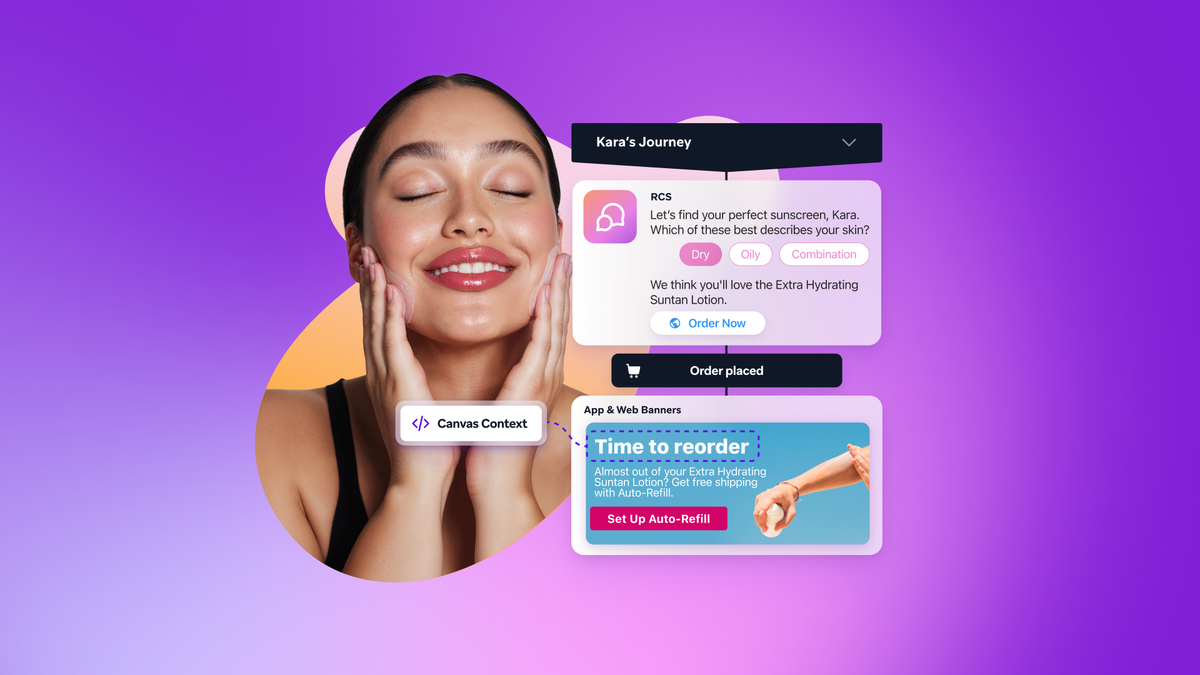Rich, Compelling, Trusted: Introducing native Braze support for RCS
Published on May 20, 2025/Last edited on May 20, 2025/7 min read


Lexie Haggerty
Senior Product Marketing Manager, BrazeThe year is 2025. You’re in an elevator, scrolling social media, and see a pair of sunglasses you like. You buy them with one tap and instantly receive an order confirmation—all before the elevator doors even open. You connect with a friend who is traveling overseas on WhatsApp—sending each other voice notes and videos to catch up. Then you open up your Messages app and receive a…not-so-engaging SMS message from a brand. It’s a plain text message with a blue hyperlink prompting you to “Shop the sale,” but you don’t know which brand the message is from, let alone what’s on sale. These sort of lackluster experiences have motivated the cellular industry to catch up by introducing RCS for Business, which helps brands deliver the richer experiences consumers have grown accustomed to on third-party messaging apps and social platforms.
RCS messaging, the next generation of text messaging, is set to change how consumers interact with each other and with the brands they love. And today, Braze is announcing native support for RCS, allowing brands to easily create immersive, conversational experiences for their high-value mobile customers.
RCS marketing is ushering in a new era of mobile messaging
RCS (short for Rich Communication Services) is an evolution of SMS/MMS. It offers the benefits of a direct, high engagement channel, just like SMS, but with richer, more engaging capabilities that modern consumers have come to expect. Unlike WhatsApp and other messaging apps that have to be downloaded from the app store, RCS is bringing these capabilities directly to consumers’ native, pre-installed messaging apps—Apple and Google Messages.
RCS messaging is quickly gaining momentum and popularity
To understand why RCS is getting so much attention now, it helps to take a look at the historical landscape. RCS has been the standard for messages sent between Android users since 2019, while messages sent between iPhone users are delivered as iMessages. Communications between Android and iPhone users were historically sent as SMS. That was until September of 2024, when Apple shook things up and began supporting RCS in an effort to improve the peer-to-peer (P2P) messaging experiences between users on the different platforms (enabling typing indicators, higher resolution image sharing, and other well-loved features). Now that marketing and transactional messages can be sent by brands to both Android and iPhone users, this channel is quickly gaining adoption, setting the stage for a new era of mobile messaging for marketers around the world.RCS already boasts 1.2 billion active users and is expected to reach 2.1 billion active users globally by the end of 2025. With carriers around the world ramping up support in 2025, RCS is on track to become as ubiquitous as SMS over the coming years.

RCS is the next generation of SMS/MMS
While SMS isn’t going away any time soon, RCS does offer some major benefits over its predecessor, including:
- Verified, branded messaging: Send RCS from a secure, verified sender that includes your brand name, logo, tagline, contact information, and a verification badge—bolstering customer trust and reinforcing your brand identity.
- Richer content: Enhance your messages with rich media like images, GIFs, videos, audio, documents, and more.
- Conversational interactions: Inspire action and have richer conversations using easy-to-tap suggested actions and suggested replies.
- Robust analytics: Leverage “read” analytics and click metrics to gain better customer insights and adjust your strategy to drive more conversions.
RCS represents an enormous opportunity for marketers in industries where trust is paramount, like financial services and healthcare, because it offers secure, verified sending. This indicates your brand was vetted by the mobile carriers—confirming to customers that you really are the brand you appear to be. The channel’s richer capabilities are also a game-changer for any brand who wants to highlight their products and services and interact with their customers in new, more dynamic ways—from retail and eCommerce brands to media companies to delivery services and more. “RCS for Business is ushering in a new era of mobile messaging that aligns with the expectations of modern consumers,” said Stephen Brough, Global GTM Head, RCS for Business at Google. “With RCS, marketers can transform traditional text messaging into richer, personalized, and conversational experiences—all while meeting customers where they already are. By delivering these immersive experiences directly within consumers’ native messaging apps, brands can achieve higher read rates, engagement, and conversions.”
Marketers aren’t the only ones clamouring over RCS. Consumers also prefer RCS over SMS. In fact, 74% of consumers are more likely to communicate with a brand through RCS than SMS and they’re 35X more likely to read RCS messages than emails. The channel's branded elements, combined with convenient features like suggested replies, make consumers feel like they’re part of an authentic conversation with a brand—not just on the receiving end of one-sided promotions and updates.

Want a deeper dive into how RCS stacks up against other channels like SMS/MMS, and WhatsApp? Check out SMS, RCS, WhatsApp, and more: Choosing the right channels for your audience.
Create more memorable, authentic experiences with Braze RCS
Braze now natively supports RCS, enabling brands to create richer, branded messages that power compelling, trusted interactions with their high-value mobile customers. Serve up immersive, conversational experiences— directly in consumers’ preinstalled messaging apps.With Braze RCS, you can:
- Seamlessly upgrade SMS to RCS and scale with confidence: Flexibly upgrade SMS to RCS at any scale with versatile sending options and built-in compliance tools. Maximize deliverability with SMS fallback, which delivers your RCS messages as SMS when a device or carrier doesn’t support RCS.
- Send trusted messages that strengthen customer relationships: Send verified messages that customers know are from your brand and boost brand recognition by transforming your RCS message thread into an owned digital space. Use “read” analytics to gain better insight into how your messages are resonating.
- Create memorable 1:1 experiences that convert: Use your first-party data to create 1:1 personalized experiences with compelling rich content that shows off your products and reflects your customers’ preferences and behaviors. Leverage BrazeAI™ to create messages that are as unique as each customer with the perfect combination of content, products, and more.
- Orchestrate guided, interactive experiences in real time: Guide your customers to their next high-value action, collect customer preferences, and create immersive experiences with personalized suggested actions and suggested replies. Easily orchestrate two-way messaging using our intuitive journey builder tool Canvas and respond to inbound replies from customers in real time.
Final thoughts
When it comes to text message marketing, the rise of RCS represents a major step forward. But, as with any new technologic advancement, making the most of this channel means getting onboard and doing the work to add these cutting-edge capabilities to your customer engagement efforts. For marketers who start now, there's an opportunity to get ahead of the pack, demonstrate what exceptional experiences can look like when marketing via text, and deepen relationships with your audience.
Ready to stand out against your competition by sending your first Braze RCS campaign? Connect with Braze to learn more about our RCS capabilities and what they can make possible for your brand.
Forward-Looking Statements
This blog post contains “forward-looking statements” within the meaning of the “safe harbor” provisions of the Private Securities Litigation Reform Act of 1995, including but not limited to, statements regarding the performance of and expected benefits from Braze and its products and features. These forward-looking statements are based on the current assumptions, expectations and beliefs of Braze, and are subject to substantial risks, uncertainties and changes in circumstances that may cause actual results, performance or achievements to be materially different from any future results, performance or achievements expressed or implied by the forward-looking statements. Further information on potential factors that could affect Braze results are included in the Braze Annual Report on Form 10-K for the fiscal quarter ended January 31, 2025, filed with the U.S. Securities and Exchange Commission on March 31, 2025, and the other public filings of Braze with the U.S. Securities and Exchange Commission. The forward-looking statements included in this blog post represent the views of Braze only as of the date of this blog post, and Braze assumes no obligation, and does not intend to update these forward-looking statements, except as required by law.
Related Tags
Releated Content
View the Blog
Move up the personalization spectrum: Introducing RCS, Banners, and Canvas Context

Haley Trost

Rich, Compelling, Trusted: Introducing native Braze support for RCS

Lexie Haggerty

May 2025 Bonfire Marketer of the Month: King’s Shelley Drogt
